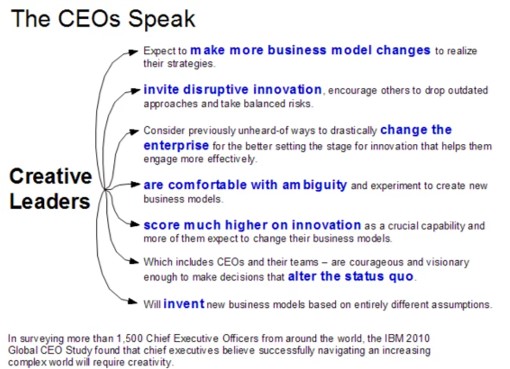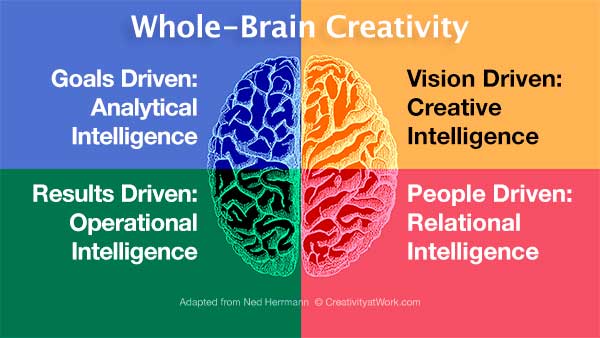
GUEST POST from Linda Naiman
According to the IBM 2010 Global CEO Study, which surveyed 1,500 Chief Executive Officers from 60 countries and 33 industries worldwide, CEOs believe that,
“More than rigor, management discipline, integrity or even vision — successfully navigating an increasing complex world will require creativity.”

CEOs say creativity helps them capitalise on complexity
“The effects of rising complexity calls for CEOs and their teams to lead with bold creativity, connect with customers in imaginative ways and design their operations for speed and flexibility to position their organisations for twenty-first century success.”
Amen to that! If we are going to find solutions in a world that is becoming increasingly interconnected and complex, we cannot rely on traditional ways of leading and managing.
Creativity is the most important leadership quality
Facing a world becoming dramatically more complex, it is interesting that CEOs selected creativity as the most important leadership attribute. Creative leaders invite disruptive innovation, encourage others to drop outdated approaches and take balanced risks. They are open-minded and inventive in expanding their management and communication styles, particularly to engage with a new generation of employees, partners and customers.
High-performing CEOs practice and encourage experimentation and innovation throughout their organisations. Creative leaders expect to make deeper business model changes to realise their strategies. To succeed, they take more calculated risks, find new ideas and keep innovating in how they lead and communicate.
The most successful organisations co-create products and services with customers, and integrate customers into core processes.
They are adopting new channels to engage and stay in tune with customers. By drawing more insight from the available data, successful CEOs make customer intimacy their number one priority.
95 percent of top performing organizations identified getting closer to customers as their most important strategic initiative over the next five years – using Web, interactive, and social media channels to rethink how they engage with customers and citizens. They view the historic explosion of information and global information flows as opportunities, rather than threats.
Better performers manage complexity on behalf of their organisations, customers and partners.
They do so by simplifying operations and products, and increasing dexterity to change the way they work, access resources and enter markets around the world. Compared to other CEOs, dexterous leaders expect 20 percent more future revenue to come from new sources. 54 percent of CEOs from top performing companies indicated they are learning to respond swiftly with new ideas to address the deep changes affecting their organizations.
Source:
IBM 2010 Global CEO Study: Creativity Selected as Most Crucial Factor for Future Success — May 18, 2010
My reflection
As a practitioner in the world of business creativity and innovation over the past twenty years, I am heartened by this encouraging news. We’ve all been tracking the success of innovators at companies like Google and Apple, and now it looks like a second wave of creativity and innovation is penetrating C-level leadership. We truly have entered the Age of Creativity.
Develop creative leadership in your business:
- Discover your Creativity and Innovation styles
- Leverage the four intelligences of creative thinking in your team
- Develop a language and structure for managing the creative process
- Create a climate conductive to fostering creativity and innovation
- Design and conduct high-performance idea-generation/problem-solving sessions
- Recognize when and how creativity is stifled and be able to prevent this
- Build innovation and critical thinking into individual and teamwork processes.
Image credits: Pixabay and Linda Naiman
![]() Sign up here to get Human-Centered Change & Innovation Weekly delivered to your inbox every week.
Sign up here to get Human-Centered Change & Innovation Weekly delivered to your inbox every week.
